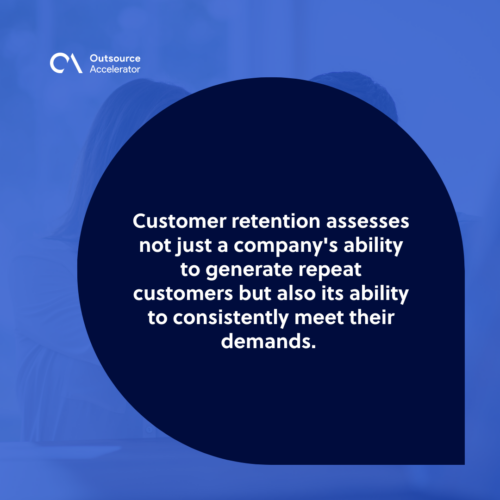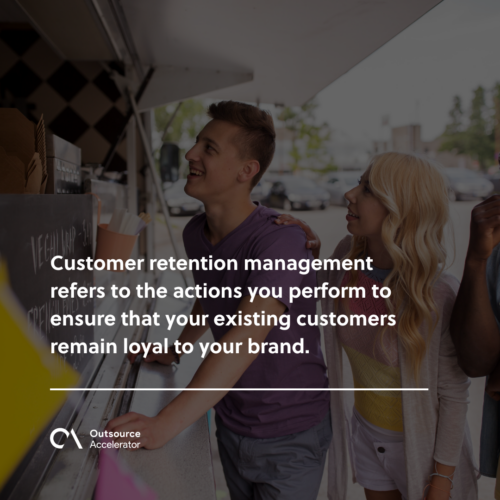Customer retention
Definition
What is customer retention?
Customer retention is the set of operations used by a company to maintain and produce more repeat customers.
Customer retention methods allow companies to give and collect additional value from their current customer base. You want to ensure that the clients you strived to get stay with you, have a positive customer experience, and continue to benefit from your services.
Why is customer retention important?
Customer retention assesses not just a company’s ability to generate repeat customers but also its ability to consistently meet their demands. It also raises ROI, promotes loyalty, and attracts potential clients.

How to calculate your customer retention rate
Customer retention rate (CRR) represents the percentage of customers gained by a firm over time.
To calculate your CRR, divide the number of new customers obtained by the number of customers remaining at the end of the period. Divide that amount by the total number of clients at the start and multiply by 100 to get the percentage.
Customer retention rate = [(Customers at the end of the period – new customers during this period) / Total customers at the beginning of the period] x 100
The customer retention rate is the opposite of the customer churn rate, which measures the proportion of customers abandoned by a firm over a certain period.
How to improve customer retention
Organizations recognize that customer profitability continues to move over the course of a retained customer. Implementing customer retention techniques is a beneficial use of corporate resources.
The following are some of the most effective customer retention methods and techniques.
Develop customers’ expectations
Set consumer expectations early. This is important to minimize confusion about the level of service you can provide.
This also keeps your company in check, as it ensures you always deliver on your commitments.
Be the customers’ go-to person for advice
You must be an expert in your profession to acquire customers’ trust and establish customer loyalty.
Build trust through connections
Develop trusting connections with your customers. Brands can do so by emphasizing common values and cultivating customer connections.
Utilize social media to build relationships
Connect and engage with consumers through social media sites like LinkedIn, Twitter, and Facebook. Provide a platform for them to share their experiences with your firm so they may become brand ambassadors.
Make it your own
Personalized service enhances the client experience and is something that customers expect and demand. Make their experience personal to deepen their connection with your business.
Who manages customer retention?
Customer success is often in charge of customer retention. This team’s duty is to work with and engage your consumers throughout their relationship with your business.
Customer success teams should not only work directly with customers to enhance and sustain retention rates. They should also collaborate with other teams within your business.
In addition, customer success should help teams such as sales, customer service, and support. It is a position with the opportunity to have a direct influence on retention.
Brands should also organize, manage, and enhance all aspects of the customer experience. As a result, your whole company will work together to continually improve customer retention.
What is customer retention management?
Customer retention management refers to the actions you perform to ensure that your existing customers remain loyal to your brand.
Here are some of the strategies that might help you with customer retention management.
Set expectations early and often.
Customers might easily become disappointed if expectations are not established and communicated effectively. They might feel you can offer specific outcomes when, in fact, such results will be seen only in months or with more effort and work input.
Meeting demands is critical for ensuring expectations are achieved. This will keep customers satisfied with the connection for a longer time.

Communicate results on a regular basis.
Consumers will be more willing to stick with your brand if your product or service provides them with results and return on investment. If a customer can verify that your organization has affected or boosted leads, the customer will find it more difficult to leave.
This means you’ll need a robust system for tracking and reporting on the metrics that are most important to the customer, which should be related to the goals you set together.
Be open about the activities you completed each month, where you see possibilities for development, and what you plan to work on the next month. Use a project management tool so the client can easily see how far along the team is in a project.
Ask for feedback and act on this information.
You can’t enhance customer retention until you first understand why people abandon your brand. Once you’ve identified the causes, you may attempt to avoid customer turnover by dealing with problems as they occur.
Encourage regular feedback from the entire customer team, including the decision-maker. Track trends by either the consumer or the person using a customer feedback tool.
Being able to recognize and address concerns as soon as possible can help you avoid losing consumers in the first place. Use the consumer’s voice as a valuable customer retention technique.







 Independent
Independent




